Serengeti National Park is one of Tanzania’s most famous and largest national parks, covering approximately 14,763 square kilometers. The park is located in northern Tanzania, bordering Kenya’s Maasai Mara National Reserve, and is part of the Serengeti ecosystem. It is partially adjacent to the Kenyan border and northwest of the adjoining Ngorongoro Conservation Area. The Serengeti National Park in Tanzania is famous for hosting the Great Wildlife Migration. This includes millions of wildebeests, zebras, and antelopes. The park is divided into three sections. Each with its distinct characteristics: the Seronera Valley, the Western Corridor, and the Northern Serengeti. It’s also a massive, wild game park, home to Africa’s Big Five.

Serengeti National Park I Ultimate Safari Destination
Serengeti National Park is also known for its ultimate safari experiences. The park’s several lodges and camps provide a variety of activities. These include; guided walks, hot-air balloon safaris, and night game drives that allow visitors to get up close to the park’s vast expanse. Additionally, the park is home to a diverse range of habitats, from acacia woodlands to riverine forests. Each with its unique wildlife species, providing visitors with a rich and diverse safari experience. The Serengeti National Park is well-known for its vast, open plains, home to some of Africa’s most iconic wildlife. Including the famous Big Five – elephants, lions, leopards, rhinos, and buffalos. However, the park is best known for its annual wildebeest migration. Hence millions of wildebeest, zebras, and other grazers move through the park in search of new grazing grounds. The migration is regarded as one of the most incredible natural spectacles on Earth, drawing thousands of visitors each year.

The Annual Migration in Serengeti National Park
The annual migration of wildebeest and other herbivores through the endless plains of Serengeti National Park is one of the most spectacular natural events on the planet. Animals are constantly moving in search of water and new grazing areas. The rains trigger the migration, determining when the herds will move to different areas of the park. The migration typically takes place between December and July, with the exact timing determined by the weather patterns of the year.
From December to March, wildebeest and other herbivores are typically found in the southern part of the Serengeti National Park, where they birth their offspring. During calving season, visitors to the park can see thousands of newborn animals take their first steps. From March to May, the herds begin migrating northward, crossing the Grumeti River and heading to the central Serengeti. In June and July, the wildebeest migrate to the northern Serengeti and cross the Mara River into Kenya’s Masai Mara. They remain at the north Serengeti until October before returning to the southern Serengeti.
It’s worth noting that temperatures in the Serengeti vary throughout the day, with early mornings and evenings being cooler than midday. It’s also important to pack appropriate clothing for the changing temperatures and the possibility of rain during the wet season.
Serengeti Plain
The Serengeti National Park is part of this plain and famous for its annual wildebeest migration, regarded as one of the world’s most spectacular natural spectacles. The Serengeti Plain also supports a diverse range of wildlife, including lions, cheetahs, leopards, giraffes, zebras, and numerous bird species. The plain is an essential component of the Serengeti ecosystem and a must-see attraction for anyone visiting Tanzania. Offering enchanting wildlife and exploration of the vast grasslands through some of the most popular safaris like Hot air balloon safaris providing a unique view of the plain from above. Hence allows you to spot the animals and landscape from an entirely novel angle. Walking safaris, on the other hand, allows you to get up close to nature while exploring the Serengeti Plain by foot. Game drives are the most common safari activity, providing an opportunity to see wildlife up close from the comfort of a safari vehicle.

